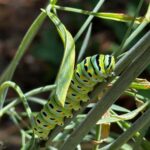Showcase Feature
Nancy, who has been attending the Tour since its inception in 2005, has long had an affinity for native plants, and it shows in the garden she designed and installed. The garden in front of this 1902 Queen Anne (note the irregularly shaped, steeply pitched roof, and the asymmetrical façade) features a stately Dr. Hurd manzanita with an understory of fescues, iris, and lower-growing manzanitas. Except for new plants that are getting established, this garden is not watered at all.
 In the back garden Nancy created a peaceful, contemplative space—note the boulder-lined asymmetric garden beds, the charming, gently meandering path, and the sense of enclosure provided by the trees and shrubs. Stroll through the rose-arbor entrance to the wooded forest bathing area, which is ringed with three sweetly-scented California lilac, an elderberry, island mallow, lemonade berry, and fruit trees. Take a seat in this tranquil haven and “forest bathe” yourself—meaning, relax in the atmosphere of the forest, become aware of the beauty around you, enjoy the sunlight shining through the leaves, and reap the health benefits that come from being in nature.
In the back garden Nancy created a peaceful, contemplative space—note the boulder-lined asymmetric garden beds, the charming, gently meandering path, and the sense of enclosure provided by the trees and shrubs. Stroll through the rose-arbor entrance to the wooded forest bathing area, which is ringed with three sweetly-scented California lilac, an elderberry, island mallow, lemonade berry, and fruit trees. Take a seat in this tranquil haven and “forest bathe” yourself—meaning, relax in the atmosphere of the forest, become aware of the beauty around you, enjoy the sunlight shining through the leaves, and reap the health benefits that come from being in nature.
Other Garden Attractions
• Note the series of large ceramic pots planted with yerba buena, lewisia, and succulents that define the arc of the curving, pebble-strewn garden path.
• The garden beds were raised, creating visual interest, and providing the drainage most natives need.
• Lippia repens (aka Phyla nodiflora) functions as a lawn substitute.
•  This garden contains a potpourri of fruit trees, including plum, peach, persimmon, lemon, apple, Asian pear, mandarin, and Japanese yuzu. Edibles scattered throughout the beds of natives include onions, collards, and other greens.
This garden contains a potpourri of fruit trees, including plum, peach, persimmon, lemon, apple, Asian pear, mandarin, and Japanese yuzu. Edibles scattered throughout the beds of natives include onions, collards, and other greens.
• Tom, who plays recorder, will perform in the garage intermittently throughout the day. Come on into the garage, take a seat, and hope that Tom will play the “Bird Fancyers Delight” for you—written in 1717, this piece contains melodies taken from eleven bird species songs. (Ask, if you would like to hear it!)
Gardening for Wildlife
Last year Bewick’s wrens nested in the bird box! Hummingbirds, the wrens, California towhees, lesser goldfinches, Steller’s jays, monarchs and other butterflies fly and flutter through the garden.
Check out the catio, which keeps the family’s cats, and birds, safe.
Keystone species (watch this talk by Doug Tallamy!)
Keystone species—our own, local ecological powerhouse plants—in this garden include Catalina cherry, huckleberry, red flowering, golden and Catalina currants, California lilac, snowberry, lupine, sage, manzanita, strawberry, aster, ocean spray, coffeeberry, honeysuckle, and elderberry.
 Green Home Features
Green Home Features
HVAC Heat pumps: This large home has two heat pumps for heating and cooling the house: a Fujitsu Airstage ducted system keeps the first two floors comfortable, and a Fujitsu ductless mini-split system was installed on the third floor. (This meant that ducts would not have to be installed in the attic room, which didn’t already have them.)
Heat pump for heating water: HPSX-66 State self-contained heat pump water heater.
Solar panels: The solar panels were installed about 20 years ago, and will be replaced with better-performing panels in the future.
Garden Talks
2:00-5:00! Friendly and knowledgable Electrify My Home staff will be available to talk with you about why to electrify, how to replace your gas furnace or water heater with heat pumps, and about electrification rebates, insulation, and more. Take a look at Nancy and Tom’s compressors, and get your electrification questions answered here!
11:00 “The only constant is change: lawn replacement, tree removal, moving plants around, and surrendering to shade—join me to learn how the garden has changed over time” by Nancy Beckman
Wondering what to make for dinner? Try this great recipe!
Stir-fried Collard Greens
Nancy says: “We love collard greens for their crunchy texture and subtle earthy flavor. They grow in the garden all year long so they are available anytime. Whenever we want to eat healthy greens, there they are! Once established, they need no water. In our experience, tree collards grow to 6-8’ tall, in a part-sun garden. Because they’re so tall, insects rarely make the trek up to eat them!”
At least partially wheelchair accessible? yes
Photos
Click to see as a slideshow:
- Hapithus Agitator






























